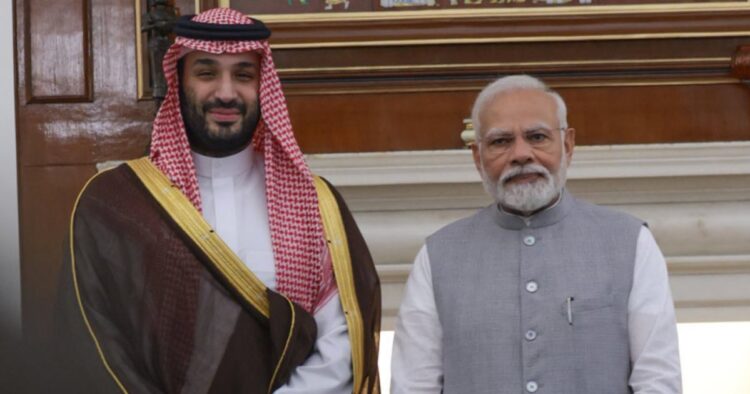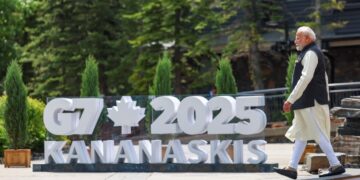KEY POINTS
- PM Modi’s visit aims to boost India-Saudi ties through energy, trade, and defence cooperation
- Strategic Partnership Council to hold its second session in Jeddah during the visit
- 2.6 million Indians in Saudi Arabia strengthen cultural and economic connections
India is ready to take a big step in its relationship with Saudi Arabia, a move that could change the future of India’s ties with the entire Gulf and Islamic world. Read this article till the end to understand how India is building deep and lasting friendships in West Asia through trust, trade, and strategic cooperation.
Prime Minister Narendra Modi’s upcoming visit to Saudi Arabia is being called a milestone in India’s growing influence in the Middle East. But this relationship didn’t just start now. Over the past decade, India has worked hard to build a strong bond with Saudi Arabia, a bond based on mutual respect, trade cooperation, and shared goals.
This will be PM Modi’s third visit to the Kingdom. His earlier visits, especially the one in 2019, led to the formation of the Strategic Partnership Council (SPC), a high-level body co-chaired by the leaders of both countries. This council was created to improve cooperation in important areas like politics, security, culture, and the economy. The second session of this council is now set to take place in Jeddah during PM Modi’s visit.
Former Foreign Secretary Harsh Vardhan Shringla said that under PM Modi’s leadership, India’s relationship with not just Saudi Arabia, but the entire Gulf region has seen a major transformation. “The personal connection between PM Modi and Crown Prince Mohammed bin Salman has played a key role in moving this relationship forward,” he added.
Energy cooperation is one of the main reasons why Saudi Arabia is so important to India. As one of the largest suppliers of crude oil and petrochemicals, Saudi Arabia is vital for meeting India’s energy needs. India, being a major importer, sees Saudi Arabia as a trusted partner in energy security.
In the financial year 2023-24, bilateral trade between the two nations touched around USD 43.3 billion. India exported goods worth USD 11.56 billion to Saudi Arabia, while importing oil and other items worth USD 31.8 billion. Major Indian exports include engineering goods, rice, chemicals, ceramic tiles, petroleum products, textiles, and food items. On the other hand, India imports crude oil, fertilisers, and petrochemicals from Saudi Arabia.
India is also working closely with Saudi Arabia in terms of investment. The Public Investment Fund (PIF) of Saudi Arabia has invested in major Indian companies like Reliance Jio Platforms and Reliance Retail Ventures. Saudi Aramco, the Kingdom’s national oil company, is also exploring investments in Indian oil refineries, which shows the increasing economic trust between the two countries.
Former Ambassador Mahesh Sachdev called this visit “extremely significant,” noting Saudi Arabia’s growing role in the region and its importance to India’s foreign policy. He said, “The trade between the two countries is strong, but the investment potential is still much higher. This visit can help unlock new opportunities for economic growth on both sides.”
Defence and security cooperation between India and Saudi Arabia is also growing stronger. Both countries have discussed joint military exercises, training, and defence production. They also share intelligence to combat terrorism and maintain regional security. As Sachdev pointed out, “Saudi Arabia is looking for reliable defence partners, and India is becoming one of their most trusted allies.”
Culturally and socially, the relationship is equally strong. About 2.6 million Indians live and work in Saudi Arabia, contributing greatly to the Kingdom’s economy. They also act as a strong bridge between the people of both nations, strengthening people-to-people ties.
India’s efforts to build strong ties with Saudi Arabia didn’t start today. The Delhi Declaration (2006) and the Riyadh Declaration (2010) laid the foundation for a strategic partnership focusing on energy, trade, and security. Under PM Modi, these ties have grown even deeper and broader.
Saudi Arabia’s Vision 2030, a plan to reduce the country’s dependence on oil and diversify its economy, has opened many doors for India. India’s strengths in IT, infrastructure, pharmaceuticals, education, renewable energy, and digital innovation make it a perfect partner to help Saudi Arabia achieve its goals.
In the last few years, PM Modi has also strengthened ties with other Gulf countries like the UAE, Oman, Bahrain, and Qatar, showing India’s growing role as a dependable and friendly nation in West Asia.
In short, India’s relationship with Saudi Arabia is not just about business. It is a carefully built partnership based on friendship, shared values, and common goals. As PM Modi visits Saudi Arabia again, the bond between the two nations is only expected to grow stronger, setting an example of how India is rising as a global friend and strategic power in the Middle East.

















Comments